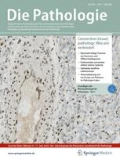Zusammenfassung
Gastroenteropankreatische endokrine bzw. neuroendokrine Tumoren (NET) umfassen ein breites Spektrum von Neoplasien mit heterogenem biologischem Verhalten. Sie unterscheiden sich bezüglich der Funktionalität, der Lokalisation und der Herkunft aus den Abschnitten des primitiven embryonalen Darmkanals, des Wachstumsmusters, des Differenzierungsgrades, der Expression neuroendokriner Markermoleküle und der Prognose. Sie treten überwiegend sporadisch, aber auch familiär z. B. bei der Multiplen Endokrinen Neoplasie (MEN) Typ 1 und dem von Hippel-Lindau- (VHL-)Syndrom auf. Die komplexen Manifestationsformen der NET spiegeln sich in den differenten bisher verwendeten, Terminologien und Klassifikationen wieder. Die Begriffe “Karzinoid” bzw. “Inselzelltumor” oder die funktionsbezogenen Bezeichnungen “Insulinom, Gastrinom, Somatostatinom” vermitteln nicht, ob die Neoplasien als benigne, potenziell maligne oder eindeutig maligne einzustufen sind. Neue klinische, morphologische und molekulare Entwicklungen auf dem Gebiet der neuroendokrinen Biologie leisten heute einen entscheidenden Beitrag zur Identifizierung und Charakterisierung von NET und bilden auch die Grundlage der aktuellen World-Health-Organization- (WHO)-Klassifikation.
Abstract
Gastroenteropancreatic endocrine or neuroendocrine tumors (NETs) encompass a broad spectrum of neoplasms characterized by a heterogeneous biological behavior. They differ with regard to functional state, localization, and derivation from various segments of the primitive embryonal gut, growth pattern, degree of differentiation, expression of different neuroendocrine marker molecules, and prognosis. They occur generally as sporadic tumors but sometimes also in the setting of a familial cancer syndrome such as in type 1 multiple endocrine neoplasia or von Hippel-Lindau syndrome. The complex manifestations of NETs are reflected by the varying terms and classification systems. However, the terms “carcinoid” and islet cell tumor” do not indicate whether the tumors are benign, malignant, or of uncertain behavior. New clinical, morphological, and molecular developments in the field of neuroendocrine biology are contributing to the identification and characterization of NETs and are considered in the current World Health Organization classification.
Author information
Authors and Affiliations
Rights and permissions
About this article
Cite this article
Schmitt-Gräff, A., Nitschke, R. & Wiedenmann, B. Gastroenteropankreatische neuroendokrine/endokrine Tumoren Aktuelle pathologisch-diagnostische Sicht. Pathologe 22, 105–113 (2001). https://doi.org/10.1007/s002920000448
Issue Date:
DOI: https://doi.org/10.1007/s002920000448

